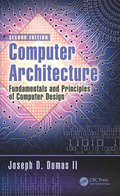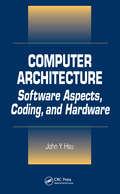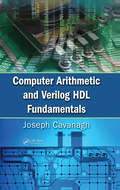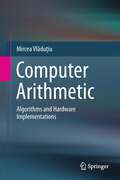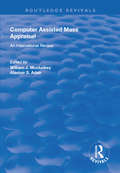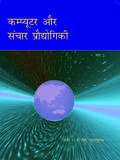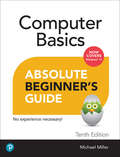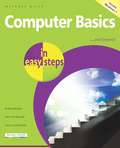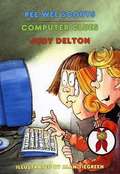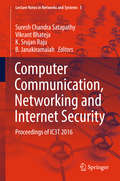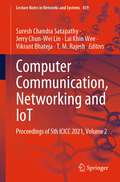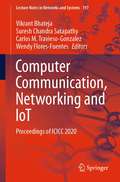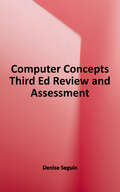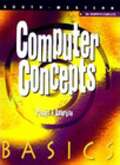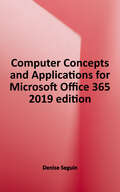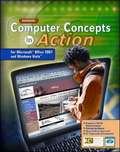- Table View
- List View
Computer Architecture: Fundamentals and Principles of Computer Design, Second Edition
by Joseph D. Dumas IINot only does almost everyone in the civilized world use a personal computer, smartphone, and/or tablet on a daily basis to communicate with others and access information, but virtually every other modern appliance, vehicle, or other device has one or more computers embedded inside it. One cannot purchase a current-model automobile, for example, without several computers on board to do everything from monitoring exhaust emissions, to operating the anti-lock brakes, to telling the transmission when to shift, and so on. Appliances such as clothes washers and dryers, microwave ovens, refrigerators, etc. are almost all digitally controlled. Gaming consoles like Xbox, PlayStation, and Wii are powerful computer systems with enhanced capabilities for user interaction. Computers are everywhere, even when we don’t see them as such, and it is more important than ever for students who will soon enter the workforce to understand how they work. This book is completely updated and revised for a one-semester upper level undergraduate course in Computer Architecture, and suitable for use in an undergraduate CS, EE, or CE curriculum at the junior or senior level. Students should have had a course(s) covering introductory topics in digital logic and computer organization. While this is not a text for a programming course, the reader should be familiar with computer programming concepts in at least one language such as C, C++, or Java. Previous courses in operating systems, assembly language, and/or systems programming would be helpful, but are not essential.
Computer Architecture: Software Aspects, Coding, and Hardware (Telecommunications And Networking Library)
by John Y. HsuWith the new developments in computer architecture, fairly recent publications can quickly become outdated. Computer Architecture: Software Aspects, Coding, and Hardware takes a modern approach. This comprehensive, practical text provides that critical understanding of a central processor by clearly detailing fundamentals, and cutting edge design features. With its balanced software/hardware perspective and its description of Pentium processors, the book allows readers to acquire practical PC software experience. The text presents a foundation-level set of ideas, design concepts, and applications that fully meet the requirements of computer organization and architecture courses.The book features a "bottom up" computer design approach, based upon the author's thirty years experience in both academe and industry. By combining computer engineering with electrical engineering, the author describes how logic circuits are designed in a CPU. The extensive coverage of a micprogrammed CPU and new processor design features gives the insight of current computer development. Computer Architecture: Software Aspects, Coding, and Hardware presents a comprehensive review of the subject, from beginner to advanced levels. Topics include:o Two's complement numbers o Integer overflow o Exponent overflow and underflow o Looping o Addressing modes o Indexing o Subroutine linking o I/O structures o Memory mapped I/O o Cycle stealing o Interrupts o Multitasking o Microprogrammed CPU o Multiplication tree o Instruction queue o Multimedia instructions o Instruction cache o Virtual memory o Data cache o Alpha chip o Interprocessor communications o Branch prediction o Speculative loading o Register stack o JAVA virtual machine o Stack machine principles
Computer Arithmetic Algorithms
by Israel KorenThis text explains the fundamental principles of algorithms available for performing arithmetic operations on digital computers. These include basic arithmetic operations like addition, subtraction, multiplication, and division in fixed-point and floating-point number systems as well as more complex operations such as square root extraction and evaluation of exponential, logarithmic, and trigonometric functions. The algorithms described are independent of the particular technology employed for their implementation.
Computer Arithmetic and Verilog HDL Fundamentals
by Joseph Cavanagh<p>Verilog Hardware Description Language (HDL) is the state-of-the-art method for designing digital and computer systems. Ideally suited to describe both combinational and clocked sequential arithmetic circuits, Verilog facilitates a clear relationship between the language syntax and the physical hardware. It provides a very easy-to-learn and practical means to model a digital system at many levels of abstraction. <p>Computer Arithmetic and Verilog HDL Fundamentals details the steps needed to master computer arithmetic for fixed-point, decimal, and floating-point number representations for all primary operations. Silvaco International’s SILOS, the Verilog simulator used in these pages, is simple to understand, yet powerful enough for any application. It encourages users to quickly prototype and de-bug any logic function and enables single-stepping through the Verilog source code. It also presents drag-and-drop abilities. <p>Designed for electrical and computer engineers and computer scientists, this book leaves nothing unfinished, carrying design examples through to completion. The goal is practical proficiency. To this end, each chapter includes problems of varying complexity to be designed by the reader.</p>
Computer Arithmetic: Algorithms and Hardware Implementations
by Mircea VlăduţiuThe subject of this book is the analysis and design of digital devices that implement computer arithmetic. The book's presentation of high-level detail, descriptions, formalisms and design principles means that it can support many research activities in this field, with an emphasis on bridging the gap between algorithm optimization and hardware implementation. The author provides a unified view linking the domains of digital design and arithmetic algorithms, based on original formalisms and hardware description languages. A feature of the book is the large number of examples and the implementation details provided. While the author does not avoid high-level details, providing for example gate-level designs for all matrix/combinational arithmetic structures. The book is suitable for researchers and students engaged with hardware design in computer science and engineering. A feature of the book is the large number of examples and the implementation details provided. While the author does not avoid high-level details, providing for example gate-level designs for all matrix/combinational arithmetic structures. The book is suitable for researchers and students engaged with hardware design in computer science and engineering.
Computer Assisted Mass Appraisal: An International Review (Routledge Revivals)
by William J. McCluskey Alastair AdairFirst published in 1997, this volume emerged in response to the need for material on the research, development, use and application of mass appraisal techniques for ad valorem property tax systems. The primary paradigms discussed include regression, base home technique, adaptive estimation procedure and artificial neural networks. Intending to address a wide range of property types, the authors explored residential, condominiums, retail, office and industrial property as well as agricultural and forestry land.
Computer Assisted Music and Dramatics: Possibilities and Challenges (Advances in Intelligent Systems and Computing #1444)
by Ambuja Salgaonkar Makarand VelankarThis book is intended for researchers interested in using computational methods and tools to engage with music, dance and theatre. The chapters have evolved out of presentations and deliberations at an international workshop entitled Computer Assisted Music and Dramatics: Possibilities and Challenges organized by University of Mumbai in honour of Professor Hari Sahasrabuddhe, a renowned educator and a pioneering computational musicologist (CM) of Indian classical music. The workshop included contributions from CM as well as musicians with a special focus on South Asian arts. The case studies and reflective essays here are based on analyses of genres, practices and theoretical constructs modelled computationally. They offer a balanced and complementary perspective to help innovation in the synthesis of music by extracting information from recorded performances. This material would be of interest to scholars of the sciences and humanities and facilitate exchanges and generation of ideas.
Computer Assisted and Robotic Endoscopy and Clinical Image-Based Procedures
by Cristina Oyarzun Laura Raj Shekhar Stefan Wesarg Miguel Ángel González Ballester Klaus Drechsler Marius Erdt Marius George Linguraru Xiongbiao Luo Tobias Reichl Kensaku Mori M. Jorge Cardoso Terry Peters Tal Arbel Andreas Uhl Jonathan McLeodThis book constitutes the refereed joint proceedings of the 4th International Workshop on Computer Assisted and Robotic Endoscopy, CARE 2017, and the 6th International Workshop on Clinical Image-Based Procedures: Translational Research in Medical Imaging, CLIP 2017, held in conjunction with the 20th International Conference on Medical Imaging and Computer-Assisted Intervention, MICCAI 2017, in Québec City, QC, Canada, in September 2017. The 7 full papers presented at CARE 2017 and the 10 full papers presented at CLIP 2017 were carefully reviewed and selected. The papers deal with interventional and diagnostic endoscopy integrating the latest advances in computer vision, robotics, medical imaging and information processing and the development and evaluation of new translational image-based techniques in the modern hospital.
Computer Aur Sanchaar Prodhogiki Bhag 1 class 11 - NCERT Board: कम्प्यूटर और संचार प्रौद्योगिकी भाग 1 कक्षा 11 - एनसीईआरटी
by Rashtriy Shaikshik Anusandhan Aur Prashikshan Parishadकम्प्यूटर और संचार प्रौद्योगिकी भाग 1 कक्षा 11 वीं का पुस्तक हिंदी भाषा में राष्ट्रीय शैक्षिक अनुसंधान और प्रशिक्षण परिषद् ने प्रकाशित किया गया है । इस पाठ्यपुस्तक में छ: विषय-वस्तुओं/ यूनिटों के अंतर्गत चौदह अध्याय हैं, अर्थात् कम्प्यूटर तथा संचार प्रौद्योगिकी (Computer and Communication Technology - CCT) के संसार में स्वागत; कार्यस्थल उत्पादकता उपकरण संचार अवधारणाएं एवं कुशलताएँ; वेब प्रकाशन प्रौद्योगिकी; सामूहिक कार्य (टीमवर्क) तथा वेब आधारित सहयोग उपकरण और उभरती हुई प्रौद्योगिकियाँ। यह पुस्तक निष्ठापूर्वक तैयार की गई है और पाठ्यपुस्तक विकास समूह, स्कूलों के अध्यापक, विषय विशेषज्ञ, शिक्षाविद् और सरकारी, गैर-सरकारी तथा निजी संस्थाओं / संगठनों के तकनीकी विशेषज्ञ के सतत प्रयासों का परिणाम है । छात्र उच्च माध्यमिक स्तर के बाद भी कम्प्यूटर के बारे में अध्ययन जारी रख सकते हैं और नहीं भी, किंतु ऐसा प्रतीत होता है कि वे सीसीटी के पीछे निहित तर्क को किसी भी अन्य शाखा में उपयोगी पाएँगे, चाहे वह प्रशासन हो, सामाजिक विज्ञान हो, पर्यावरण, अभियांत्रिक (इंजीनियरिंग), प्रौद्योगिकी, जैविकी, चिकित्सा या ज्ञान की कोई भी अन्य शाखा हो ।
Computer Aur Sanchaar Prodhogiki Bhag 2 class 11 - NCERT Board: कम्प्यूटर और संचार प्रौद्योगिकी भाग 2 कक्षा 11 - एनसीईआरटी
by Rashtriy Shaikshik Anusandhan Aur Prashikshan Parishadकम्प्यूटर और संचार प्रौद्योगिकी भाग 2 कक्षा 11 वीं का पुस्तक हिंदी भाषा में राष्ट्रीय शैक्षिक अनुसंधान और प्रशिक्षण परिषद् ने प्रकाशित किया गया है । इस पाठ्यपुस्तक में छ: विषय-वस्तुओं/ यूनिटों के अंतर्गत चौदह अध्याय हैं, अर्थात् कम्प्यूटर तथा संचार प्रौद्योगिकी (Computer and Communication Technology - CCT) के संसार में स्वागत; कार्यस्थल उत्पादकता उपकरण संचार अवधारणाएं एवं कुशलताएँ; वेब प्रकाशन प्रौद्योगिकी; सामूहिक कार्य (टीमवर्क) तथा वेब आधारित सहयोग उपकरण और उभरती हुई प्रौद्योगिकियाँ। यह पुस्तक निष्ठापूर्वक तैयार की गई है और पाठ्यपुस्तक विकास समूह, स्कूलों के अध्यापक, विषय विशेषज्ञ, शिक्षाविद् और सरकारी, गैर-सरकारी तथा निजी संस्थाओं / संगठनों के तकनीकी विशेषज्ञ के सतत प्रयासों का परिणाम है । छात्र उच्च माध्यमिक स्तर के बाद भी कम्प्यूटर के बारे में अध्ययन जारी रख सकते हैं और नहीं भी, किंतु ऐसा प्रतीत होता है कि वे सीसीटी के पीछे निहित तर्क को किसी भी अन्य शाखा में उपयोगी पाएँगे, चाहे वह प्रशासन हो, सामाजिक विज्ञान हो, पर्यावरण, अभियांत्रिक (इंजीनियरिंग), प्रौद्योगिकी, जैविकी, चिकित्सा या ज्ञान की कोई भी अन्य शाखा हो ।
Computer Basics Absolute Beginner's Guide, Windows 11
by Michael MillerMake the most of your Windows 11 laptop or desktop computer--without becoming a technical expert! This book is the fastest way to get comfortable, get productive, get online, get started with social networking, make more connections, and have more fun! Even if you've never used a Windows computer before, this book shows you how to do what you want, one incredibly clear and easy step at a time. Computer basics have never, ever been this simple! <P><P> Who knew how simple using computers could be? <P><P> This is today's best beginner's guide to using your computer or tablet with the Windows 11 operating system...simple, practical instructions for doing everything you really want to do! <P><P> Here's a small sample of what you'll learn: <BR> <BR> Set up your computer and personalize the Windows 11 Start menu and desktop <BR> Connect to the Internet and browse the Web with Microsoft Edge <BR> Get started with social networking on Facebook, Twitter, Pinterest, and LinkedIn <BR> Video chat with Zoom and Microsoft Teams <BR> Use Windows 11's built-in apps--and find great new apps in the Microsoft Store <BR> Connect printers and external storage <BR> Connect to a home wireless network or public Wi-Fi hotspot <BR> Go online to shop and sell--including ordering food and groceries online <BR> Get work done quickly with Microsoft Office <BR> Organize, view, and share photos <BR> Listen to streaming music with Pandora and Spotify <BR> Watch streaming movies and TV shows with Amazon Prime Video, Disney+, HBO Max, Hulu, Netflix, and more <BR> Protect yourself against viruses, spyware, and spam
Computer Basics in Easy Steps - Windows
by Michael PriceComputer Basics in Easy Steps explores the elements that make up a computer and tells readers how to perform important tasks. Whether it's communicating with friends and family across the world, writing reports, or taking advantage of the Internet, this book covers it all. Computer hardware and software functions are fully covered, with a special emphasis on the tasks savvy users want to perform to increase productivity and enhance satisfaction. The book also helps readers take full advantage of other devices such as iPods, PDAs, pocket PCs, digital cameras, printers, scanners, and cell phones. Whatever readers want to do, with this book they discover how to make their computer unlock powerful new ways to extend their knowledge and experience.
Computer Clues (Pee Wee Scouts #36)
by Judy DeltonThe Pee Wees are entering cyberspace! The scouts are earning their computer badges, and that means lots of fun--and lots of surprises--are in store. From surfing the Web to sending e-mail to going on a cyber treasure hunt, the online adventures keep getting better and better. And when Molly receives an e-mail message from a secret admirer, she and Mary Beth have an exciting computer mystery to solve. The Pee Wees goof around, do good deeds, take on projects and have fun and adventures. Find out all about what scouts do in the other 38 Pee Wee Scout books you can get from Bookshare including: #1 Cookies and Crutches, #2 Camp Ghost-Away, #3 Lucky Dog Days, #4 Blue Skies, French Fries, #5 Grumpy Pumpkins, #6 Peanut-Butter Pilgrims, #7 A Pee Wee Christmas, #8 That Mushy Stuff, #9 Spring Sprouts, #10 The Pooped Troop, # 11 The Pee Wee Jubilee, #12 Bad, Bad, Bunnies, #13 Rosy Noses, Frozen Toes, #14 Sonny's Secret, #15 Sky Babies, #16 Trash Bash, # 17 Pee Wees On Parade, #18 Lights, Action, Land-ho!, # 19 Piles of Pets, #20 Fishy Wishes, #21 Pee Wees On skis, #22 Greedy Groundhogs, #23 All Dads on Deck, #24 Tricks and Treats, #25 Pee Wees on First, # 26 Super Duper Pee Wees, #27 Teeny Weeny Zucchinis, #28 Eggs With Legs, #29 Pee Wee Pool Party, #30 Bookworm Buddies, #31 Moans and Groans and Dinosaur Bones, #32 Stage Frightened, #33 Halloween Helpers, #34 Planet Pee Wee, #35 Pedal Power, #37 Wild, Wild West, #38 Here Come the Clowns, and #39 Molly For Mayor.
Computer Communication, Networking and Internet Security: Proceedings of IC3T 2016 (Lecture Notes in Networks and Systems #5)
by Suresh Chandra Satapathy Vikrant Bhateja K. Srujan Raju B. JanakiramaiahThe book is a compilation of high-quality scientific papers presented at the 3rd International Conference on Computer & Communication Technologies (IC3T 2016). The individual papers address cutting-edge technologies and applications of soft computing, artificial intelligence and communication. In addition, a variety of further topics are discussed, which include data mining, machine intelligence, fuzzy computing, sensor networks, signal and image processing, human-computer interaction, web intelligence, etc. As such, it offers readers a valuable and unique resource.
Computer Communication, Networking and IoT: Proceedings of 5th ICICC 2021, Volume 2 (Lecture Notes in Networks and Systems #459)
by Suresh Chandra Satapathy Vikrant Bhateja Jerry Chun-Wei Lin Lai Khin Wee T. M. RajeshThis book features a collection of high-quality, peer-reviewed papers presented at the Fifth International Conference on Intelligent Computing and Communication (ICICC 2021) organized by the Department of Computer Science and Engineering and Department of Computer Science and Technology, Dayananda Sagar University, Bengaluru, India, on November 26 – 27, 2021. The book is organized in two volumes and discusses advanced and multi-disciplinary research regarding the design of smart computing and informatics. It focuses on innovation paradigms in system knowledge, intelligence, and sustainability that can be applied to provide practical solutions to a number of problems in society, the environment and industry. Further, the book also addresses the deployment of emerging computational and knowledge transfer approaches, optimizing solutions in various disciplines of science, technology, and healthcare.
Computer Communication, Networking and IoT: Proceedings of ICICC 2020 (Lecture Notes in Networks and Systems #197)
by Suresh Chandra Satapathy Vikrant Bhateja Wendy Flores-Fuentes Carlos M. Travieso-GonzalezThis book features a collection of high-quality, peer-reviewed papers presented at the Fourth International Conference on Intelligent Computing and Communication (ICICC 2020) organized by the Department of Computer Science and Engineering and the Department of Computer Science and Technology, Dayananda Sagar University, Bengaluru, India, on 18–20 September 2020. The book is organized in two volumes and discusses advanced and multi-disciplinary research regarding the design of smart computing and informatics. It focuses on innovation paradigms in system knowledge, intelligence and sustainability that can be applied to provide practical solutions to a number of problems in society, the environment and industry. Further, the book also addresses the deployment of emerging computational and knowledge transfer approaches, optimizing solutions in various disciplines of science, technology and health care.
Computer Concepts
by Denise SeguinHighly visual and logically organised, this comprehensive program gives instructors and learners a seamless transition from concepts to applications coverage. <p><P>Students will learn Microsoft Office applications in a way that saves time and makes the best use of the available feature set, while learning the latest computer concepts. This solution has been designed and organized to provide a fresh look at the skills a student should know to be successful in today's world. Seguin's versatile content can be split for concepts-only or applications-only coverage.
Computer Concepts Basics
by Ann Ambrose Delores PusinsOffering a basic introduction to computers, this text covers computer hardware, software, input, applications skills, the Internet and Web page creation, careers, computer ethics and more. Step-by-step instructions along with numerous screen shots and illustrations help readers learn and master essential computer concepts and skills.
Computer Concepts and Applications for Microsoft Office 365
by Denise SeguinHighly visual and logically organised, this comprehensive program gives instructors and learners a seamless transition from concepts to applications coverage. Students will learn Microsoft Office applications in a way that saves time and makes the best use of the available feature set, while learning the latest computer concepts. <p><po>This solution has been designed and organised to provide a fresh look at the skills a student should know to be successful in today's world. Seguin's versatile content can be split for concepts-only or applications-only coverage.
Computer Concepts and Microsoft Office 2013
by Cengage LearningEverything you need for your Introduction to Computing course! COMPUTER CONCEPTS AND MICROSOFT OFFICE 2013 ILLUSTRATED delivers the most up-to-date computer concepts and Microsoft Office 2013 skills in an accessible, easy-to-follow format.
Computer Concepts in Action
by Stephen E. HaagGlencoe'sComputer Concepts in Actionrevised edition is designed for Microsoft Office 2007 and Windows Vista. It is written specifically to meet the needs of secondary students and teachers, and meets IC3 Standards. This highly visual text teaches essential computer concepts and skills through hands-on activities and projects. Concepts such as ethics, careers, hardware and software applications, the Internet, and e-commerce, are taught using high-interest topics and real-world scenarios that are designed to engage students.
Computer Concepts in Action
by Stephen E. HaagGlencoe'sComputer Concepts in Actionrevised edition is designed for Microsoft Office 2007 and Windows Vista. It is written specifically to meet the needs of secondary students and teachers, and meets IC3 Standards. This highly visual text teaches essential computer concepts and skills through hands-on activities and projects. Concepts such as ethics, careers, hardware and software applications, the Internet, and e-commerce, are taught using high-interest topics and real-world scenarios that are designed to engage students.
Computer Crunch! (The Secret World of Alex Mack #24)
by Patricia L. Barnes-SvarneyAlex's media class is divided into two teams and both are assigned to write a newsletter. The other team is way ahead of her group and she begins to smell a rat--is there a traitor in her midst?
Computer Darpan class 1 - GSTB: કમ્પ્યુટર દર્પણ ધોરણ ૧
by Tejas R. Thakkarઓપનસોર્સ લિનક્સ ઓપરેટિંગ સિસ્ટમ આધારિત તેમજ ગુજરાત બોર્ડના કમ્પ્યૂટર વિષયને સંલગ્ન એકમાત્ર કમ્પ્યૂટર સિરીઝ.
Computer Darpan class 2 - GSTB: કમ્પ્યુટર દર્પણ ધોરણ ૨
by Tejas R. Thakkarઓપનસોર્સ લિનક્સ ઓપરેટિંગ સિસ્ટમ આધારિત તેમજ ગુજરાત બોર્ડના કમ્પ્યૂટર વિષયને સંલગ્ન એકમાત્ર કમ્પ્યૂટર સિરીઝ.
